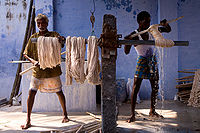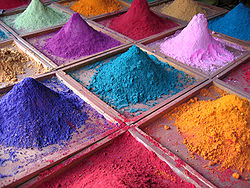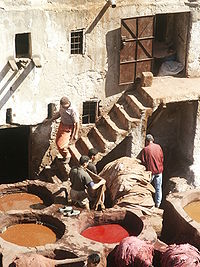
![]() FREE Pick up & Delivery
FREE Pick up & Delivery
![]() Non-Toxic Materials Used!
Non-Toxic Materials Used!
![]() We use Green & Organic Soultions
We use Green & Organic Soultions
![]() Complete Satisfaction Guaranteed!
Complete Satisfaction Guaranteed!
Call for our
24/7 EMERGENCY SERVICE
212-228-6300 Manhattan
718-222-9919 Brooklyn
718-875-5400 Queens
516-616-3945 Long Island
914-777-7334 Westchester
201-256-3334 New Jersey
203-683-3883 Connecticut
212-382-2525 NYC
Rug dyeing NY |
212-585-1900 |
Dye types
 For most of the thousands of years in which dyeing has been used by humans to decorate clothing, or fabrics for other uses, the primary source of dye has been nature, with the dyes being extracted from animals or plants. In the last 150 years, man has produced artificial dyes to achieve a broader range of colors, and to render the dyes more stable to resist washing and general use. Different classes of dye are used for different types of fibre and at different stages of the textile production process from loose fibers through yarn and cloth to made up garments. Acrylic fibers are dyed with basic dyes, nylon and protein fibers such as wool and silk are dyed with acid dyes, polyester yarn is dyed with disperse dyes. Cotton is dyed with a range of dye types including vat dyes which are similar to the ancient natural dyes and modern synthetic reactive and direct dyes.
For most of the thousands of years in which dyeing has been used by humans to decorate clothing, or fabrics for other uses, the primary source of dye has been nature, with the dyes being extracted from animals or plants. In the last 150 years, man has produced artificial dyes to achieve a broader range of colors, and to render the dyes more stable to resist washing and general use. Different classes of dye are used for different types of fibre and at different stages of the textile production process from loose fibers through yarn and cloth to made up garments. Acrylic fibers are dyed with basic dyes, nylon and protein fibers such as wool and silk are dyed with acid dyes, polyester yarn is dyed with disperse dyes. Cotton is dyed with a range of dye types including vat dyes which are similar to the ancient natural dyes and modern synthetic reactive and direct dyes.
Methods
 Direct Dye Application The term "direct dye application" stems from some dyestuff having to be either fermented as in the case of some natural dye or chemically reduced as in the case of synthetic vat and sulfur dyes before being applied. This renders the dye soluble so that it can be absorbed by the fiber since the insoluble dye has very little substantivity to the fiber. Direct dyes, a class of dyes largely for dyeing cotton, are water soluble and can be applied directly to the fiber from an aqueous solution. Most other classes of synthetic dye, other than vat and sulfur dyes, are also applied in this way. The term may also be applied to dyeing without the use of mordants to fix the dye once it is applied. Mordants were often required to alter the hue and intensity of natural dyes and improve their color fastness. Chromium salts were until recently extensively used in dying wool with synthetic mordant dyes. These were used for economical high color fastness dark shades such as black and navy. Environmental concern has now restricted their use and they have been replaced with reactive and metal complex dyes which need no mordant.
Direct Dye Application The term "direct dye application" stems from some dyestuff having to be either fermented as in the case of some natural dye or chemically reduced as in the case of synthetic vat and sulfur dyes before being applied. This renders the dye soluble so that it can be absorbed by the fiber since the insoluble dye has very little substantivity to the fiber. Direct dyes, a class of dyes largely for dyeing cotton, are water soluble and can be applied directly to the fiber from an aqueous solution. Most other classes of synthetic dye, other than vat and sulfur dyes, are also applied in this way. The term may also be applied to dyeing without the use of mordants to fix the dye once it is applied. Mordants were often required to alter the hue and intensity of natural dyes and improve their color fastness. Chromium salts were until recently extensively used in dying wool with synthetic mordant dyes. These were used for economical high color fastness dark shades such as black and navy. Environmental concern has now restricted their use and they have been replaced with reactive and metal complex dyes which need no mordant.
 The Yarn
The Yarn
There are many forms of yarn dyeing. Common forms are: at package form and at hanks form. Cotton yarns are mostly dyed at package form, and acrylic or wool yarn are dyed at hank form The common dyeing process of cotton yarn with reactive dyes at package form is given below in short: firstly the raw yarn is wound on a spring tube to achieve package suitable for dye penetration. Then, these softened packages are loaded on a dyeing carrier's spindle one on another. The packages are next pressed up to a desired height to achieve suitable density of packing. The carrier is then loaded on the dyeing machine and the yarn is dyed. After dyeing, the packages are unloaded from the carrier into a trolly. Next, all the packages are hydro extracted to remove the maximum amount of water. All the packages are then dried to achieve the final dyed package. At last the dyed yarn packages are packed and delivered.
Carpet Cleaning Articles, Tips, Tricks & Info
- Apartment Cleaning in NYC
- Area Rug Cleaning
- Bedbugs Treatment
- Best Carpet Cleaning
- Buy a Carpet 101
- Carpet Got Wet - Tips
- Carpet Installation NY
- Carpet Mold Removal
- Carpet Stain Removal Guide
- Carpet Mildew - Tips
- Carpet Sale - Tips
- Carpet Steam Cleaning
- Carpet Repair
- Choose Your Fine Rug Cleaners - How To
- Dry Carpet Cleaning
- Dust Mite Allergy Prevention
- Green Carpet Cleaning
- Fire & Smoke Damage
- Handmade Oriental Rug Cleaning NY
- Large Area Rug Cleaning
- Local Rug Cleaning
- Mattress Cleaning NYC
- Moth Rug Proofing
- Natural Rug Cleaning
- Non-Toxic Carpet Cleaning
- Old Rug Cleaning
- Oriental Rug Hand Wash
- Persian Rug Cleaning
- Rug - Dry Cleaning
- Rug Got Wet - Tips
- Rug Padding - Info
- Silk Rug Care - Info
- Tapestry Cleaning Company
- Upholstery Shampoo Cleaning
- Wall-to-Wall Carpet Info
- Water Damage Restoration
- Water Damage Mold Restoration NY
- Wool Carpet Cleaners
- Wool Rug Repair














 Copyright 2001 OrientalRugCareNY.com
Copyright 2001 OrientalRugCareNY.com